|
Vaughn Monroe Down Under
An Australian Perspective
by
Patrick Gardner
From the Beginning
Vaughn Monroe’s distinctive voice
would’ve been first heard on record and on radio in Australia some time in
April, 1940, singing with Jack Marshard’s Orchestra.
A handful of Marshard’s 1939
recordings were released in Australia on the budget-priced
“Regal-Zonophone” label in the early 1940s. (They
were coupled with reverse sides by different artists.)
The first such release with a
vocal by Vaughn was “'S Wonderful.”
It was first listed in EMI’s May 1940 summary of the previous month’s new
weekly releases. At that time Vaughn’s name wasn’t given as vocalist on
the record … but nor was Frank Sinatra’s on the reverse: “Melancholy Mood”
by Harry James and his Orchestra! It was not uncommon in those days simply
to have With Vocal Chorus (or Vocal Refrain) on the label.
’S Wonderful wasn’t Vaughn’s first
recorded vocal with Jack Marshard, but
interestingly “My Love For You” – the first – was released out of
chronological order a couple of years later, this time with the credit:
Vocal Chorus by Vaughn Monroe.
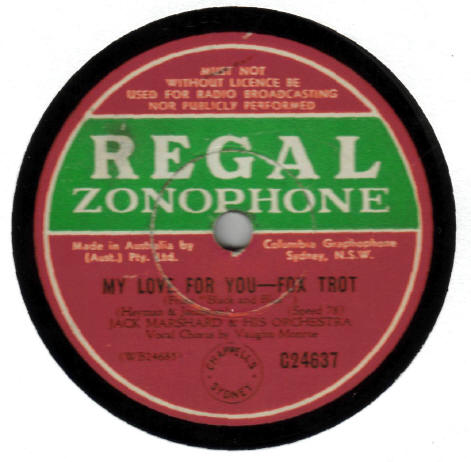
By that time Vaughn’s first
Victor/Bluebird recording with his own orchestra
(“I’m
Home Again”) had been released in Australia on
the “His Master’s Voice” full price label even though it was originally on
the lower-priced Bluebird label in the US. The backing in Australia of “My
Love For You” was “Time And Time Again,”
labelled as by “The Broadway Serenaders” with vocal chorus. This was a
pseudonym for Eddie Duchin and his orchestra with vocalist June Robbins.
(The backing of “I’m Home Again” was “Walkin’ By
The River” by Hal Kemp’s Orchestra! You might well gather that US
recordings were released somewhat differently in Australia!)
After Vaughn’s first
Victor/Bluebird release, things settled down to the norm for Australia …
ongoing releases from the US catalogue, but by no means all of them, with
as much as a couple of months or more between successive issues.
[Although
some US Banner records were put out in Australia (albeit with different
labels) from the late 1920s up to the very early 1930s, Banner does not
seem to have been represented here in 1934 when Vaughn’s Larry Funk
records were made.]
Starting with “I’m Home Again” in
September 1941, there were 65 His Master’s Voice 78s with Vaughn Monroe on
them issued in Australia up to September 1952 when the Lady Love/Idaho
State Fair coupling was released here. Thirty of
these had Vaughn on only one side so there were 100 songs issued here
during that time. That number represents only some 28 percent
of Vaughn’s US RCA-Victor releases over the same time span, but that was
something like normal in those days.


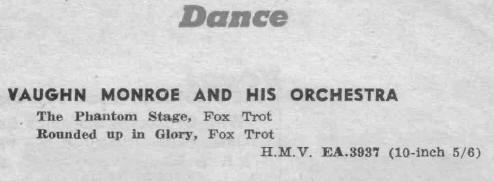
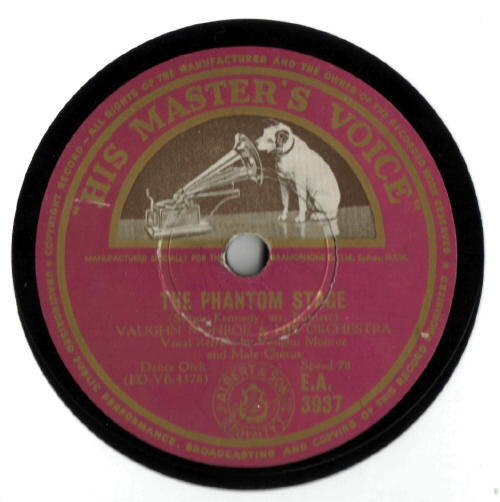
In 1953 RCA-Victor announced it
was withdrawing from the long-standing agreement to license EMI to issue
their records under the His Master’s Voice label in Australia. Similar
(though not identical) moves would be made in, for example, the UK. This
caused considerable dispute with EMI.
RCA’s moves to set up their own
pressing and distribution network in Australia for the RCA label itself
were slow to be implemented and US RCA-Victor agreed to some exceptions
during 1954. [One important instance was the licence for Australian EMI to
issue, on their His Master’s Voice label, soundtrack material from MGM’s
“The Student Prince” (on RCA in the US).
Apparently MGM in New York
intervened to get RCA-Victor to reinstate the earlier EMI agreement for
this release which otherwise wouldn’t have been issued in Australia! There
were a few other exceptions, some even quite a while later, for other
special reasons which didn’t pertain to Vaughn Monroe. Along with the
great majority of US RCA-Victor artists, Vaughn was not released in
Australia for some three years!
When RCA did finally get to
directly issue their artists on the RCA label here it was well into 1956.
Kay Starr, Eddie Fisher and Mario
Lanza were hot, and you know who (Elvis of course) had arrived. RCA’s
early releases here included “Rock and Roll Express” (b/w “There She
Goes”) and “In The Middle Of The House” (b/w “Rollin’ Heart”) by Vaughn.
Also by Vaughn, “Westward Ho The Wagons” (b/w “Wringle Wrangle”) was
released in a Children’s series and later, “Stargazer” (b/w “The Best
Dream Of All”).
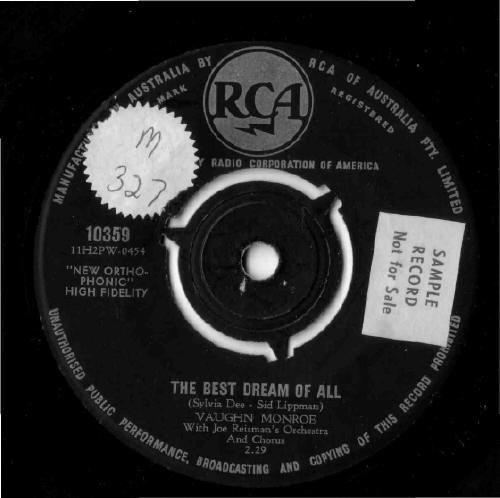
There don’t seem to have been any
more Vaughn Monroe Australian releases until an ex-Dot LP of “Vaughn
Monroe’s Greatest Hits,” and that may well have
been the last (except for a few “big hit” inclusions on “Various Artists”
retrospective compilations).
Popularity
There were no structured “Hit Parade” charts in
Australia (of the Billboard type) during the 1940s and even in the 1950s
until 1956.
Radio stations and magazines or
newspaper lift-outs associated with radio programs would sometimes
nominate popular songs, but not in “Entry Date/This Week/Last Week/Times
In” sort of format.
Australian chart
researcher David Kent compiled a formalised Top 20 Hit Parade from 1956 to
early 1958 that was incorporated in a later
publication, which continued the charts from
1958 onwards using a Sydney radio station’s listings. This is taken as a
good guide for Australia over the time it covers (though the various
states would have had many differences). Vaughn Monroe doesn’t feature,
though if the Kent Chart had gone a little further than Top 20, Vaughn’s
“In The Middle Of The House” would’ve charted late in 1956.
In any case,
David Kent has more recently researched, in hindsight, song and artist
popularity prior to 1956, in fact back to 1940. His listings and positions
are understandably based on less definite evidence than normally
associated with chart placings calculated “at the time,”
but he identifies a little over two dozen songs by Vaughn as popular here.
Some he lists were not actually released on Australian pressings which
reflects that some radio stations (particularly on the East coast)
imported American copies of certain artists’ recordings to play on air.
“When The Lights Go On Again”
starts the list in July 1943 and “In The Middle Of The House” finishes it
in November 1956. In some cases other artists are also included as having
popular versions, but Vaughn’s “big” ones were no doubt associated with
him exclusively, or more so than with other
contenders. These include (among others) “There I’ve Said It Again,”
“Kokomo Indiana,” “Ballerina,”
“The Maharajah Of Magador” (with vocal by Ziggy Talent), “Riders In The
Sky” (given a HP of No 1 by Kent), “Red Roses For A Blue Lady,”
“That Lucky Old Sun,” “Mule Train,”
“Bamboo,” “Sound Off” and “Lady Love.”
In Person
Australia has hosted many overseas
artists over the decades. In the 1950s, 1960s and beyond, package tours of
American artists were organised by the likes of Lee Gordon and others
(including TV networks). I can only confirm one such visit by Vaughn
Monroe but there could have been others. Vaughn appeared on TCN Channel
9’s show “Top of the Town” on February 10, 1961.
“Top of the Town 1961” is
described as a 55 minute B&W extravagant national variety show featuring
local and international talent, produced alternately in Sydney and
Melbourne.
Vaughn appeared together with
Bobby Rydell who, with others, had a number of appearances.
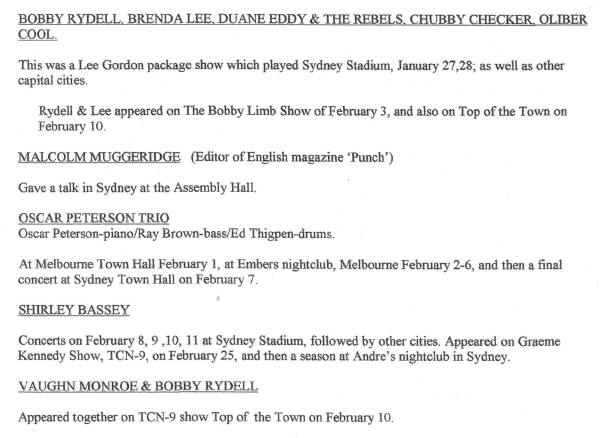
Now
Vaughn Monroe would be unlikely to
be heard much if at all on ccommercial radio in
Australia these days, but there are dozens of
“Community Broadcasters” across the country, many of which would no doubt
give him an airing.
In Western Australia there are
several such stations which would regularly include Vaughn’s most popular
recordings on “Nostalgia” type programs. As a volunteer presenter on two
such stations over a total of nearly 10 years, I played Vaughn material
quite often. In an effort to offer the listeners a wider choice of songs
than just the big hits, I had a couple of
compilations of less common tracks transferred to CD for radio play,
largely from imported American pressings. Several other presenters used
them but, by and large, Vaughn would be heard singing his big hits which,
for the older public at large, is probably just as it should be.

Submitted
by: Patrick Gardner
|